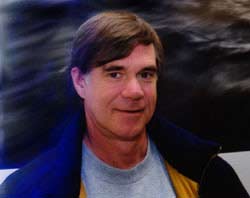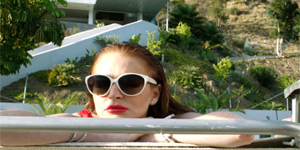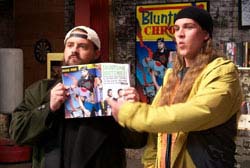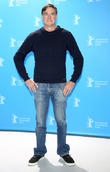
Gus Van Sant Interview
07 January 2009Gus Van Sant returns to his off-the-wall indie roots with experimental, existential 'Gerry'
(Some questions in this interview have come from another journalist present for the Q&A.)
Gus Van Sant has gotten used to being misunderstood.
The doggedly independent director is known for highly praised but unconventional fare such as the elliptical "My Own Private Idaho" (an underworld drama about gay hustlers that borrows from Shakespeare's "Henry IV"), the gritty "Drugstore Cowboy" (about a band of bottom-scraping junkies breaking into pharmacies to get their fixes) and the deliciously deadpan, loosely fact-based dark comedy "To Die For" (in which Nicole Kidman played a talentless but murderously ambitious TV weathergirl).
While he's had high profile mainstream success with the semi-indie hit "Good Will Hunting" (Van Sant was nominated for a Best Director Oscar and writers-stars Matt Damon and Ben Affleck won a screenplay Oscar), he's also downright infamous for following that film with a controversial, shot-for-shot color remake of Alfred Hitchcock's "Psycho" -- an experiment that didn't sit well with most critics and filmgoers.
"They kind of pitted me against Hitchcock. They thought I was trying to challenge Hitchcock," the director says, adding with a chuckle, "I don't know how I would challenge him if I'm using his own material."
After making another, more successful big studio picture ("Finding Forrester"), Van Sant has returned to his roots with a vengeance, directing the distinctively intrepid "Gerry," an existential film of very long takes and very little dialogue about nothing more than two buddies getting lost -- very lost -- in the desert.
Starring his close friends Matt Damon and Casey Affleck (Ben's younger brother), with whom he co-wrote the story, "Gerry" has once again divided critics and film festival audiences (Sundance and Toronto screenings saw a handful of walk-outs) with its curiously engrossing (or boring, depending on your point of view) shots that last several minutes at a stretch -- sometimes depicting modestly funny escapades (Affleck gets stuck atop a large rock), sometimes depicting monotony-relieving (or monotony-inducing, depending on your point of view) offhand conversation, and sometimes quietly capturing the unspoken fear and frustration as the men trudge blindly along, not even knowing why they're doing it anymore.
Fresh from a week's vacation in St. Bart's (the director acquired a wicked sunburn), Van Sant visited Berkeley, where we met for lunch (along with my friend Jeff Anderson from the San Francisco Examiner) and started our conversation talking about those long single takes.
| Q: With edits the filmmaker is telling you where to go and where to look. With a big, long take you have plenty of time to think of it on your own. |
A: That's sort of the point of not having cuts. [Smiles.] Usually big, long takes (are) stunts, and they weren't meant for general description. They were meant for introduction or beginnings or ends.
| Q: There's one shot that sticks in my head in which Matt's in the distance at one end of the shot and Casey's at the other end of the shot, and they trudge for what seems like 10 minutes. |
A: It's seven minutes. We shot 10 minutes, but we cut it short.
| Q: How do you decide where to cut something like that? |
A: Well, it used to be eight minutes. [Smiles an ironic smile.] But I thought maybe it was going on too long. I mean, seven minutes -- when you start talking in those lengths. There is a rhythm, but it's so elongated that it's more like an impressionistic rhythm. Other types of rhythm, when they're like under 20 seconds, it's more like a musical rhythm. We did a bunch of different takes of them walking and we chose one that we liked. We cut the beginning and the end off, mostly based on camera movement or placing. Then we had this eight-minute take that at some point I made seven minutes.
| Q: And the sun is rising during that shot. |
A: Yeah, well, we had to "effect" the film in order for that to happen. It literally goes from dark to light in seven minutes, but I think if we did it for real it would be more like 25 minutes. So we had to print it so it did that, so it went from dark to light.
| Q: Well, that effect is seamless. You slowly realize the shot is getting lighter. I thought it was the sun coming up. |
A: Really? Great! It's really, really good. It's long enough so you actually feel like the sun is coming up.
| Q: I'm surprised you shot this on film since I've read an interview with you in which you expressed curiosity about digital video. A minimalist movie like this, it seems perfect for DV. |
A: I think it's an inclination I had soon after "Drugstore Cowboy." We did "Mala Noche" (Van Sant's first feature from 1985) with three people, everything was very minimal and I really liked the way it turned out. When we did "Drugstore Cowboy," we had 80 people on the crew, and the result was we could never do anything very fast, you know? I always felt like I missed stuff because I couldn't work fast enough. Part of that certainly had to do with the technicality of moving so many different departments around. They all have to sign off. You can't exclude wardrobe or the lighting department from your set-up. So just having six departments check off on whatever your set-up is becomes time-consuming. And besides "Finding Forrester," "Drugstore Cowboy" was my biggest crew. It was like a circus. After that I just wanted a small crew, and I'd still never done that (until now).
| Q: So how many people were out in the desert (for "Gerry")? A cinematographer. Matt and Casey... |
A: We had a big grip department because we had a big camera. So we had like twice the size of a normal grip department. So that was maybe eight grip guys and some strong PAs (production assistants) that could be grips too, so it was a pretty big department. We had a huge grip truck that had a crane. We had a whole craft services water truck. We had an air-conditioned bus in case people got too hot, which they did. Then we had a mobile home for production and for the actors and me. That was our little extravagance. So we had drivers for these vehicles too.
| Q: You shot in Argentina, Utah and Death Valley -- all passing for the same desert. What's the story behind that? |
A: We wanted to get out of the country because (this was at the time of the threatened) SAG strike two years ago. You couldn't really start a project because if you hired all your people, you might have to stop the day of the strike. But our financing was from outside of the States, so as long as we shot outside of the States, it was legal for us to do it. Then we came back because Argentina was too cold and the strike didn't happen. The whole first 20 minutes (of the movie) is in Argentina, and we shot in order. That was one of our rules. We had our own little rules: No traditional coverage, no traditional screenplay and to shoot in continuity.
| Q: You say no traditional screenplay. I did want to ask you how much of the film was on paper. |
A: There was a script because the only way you can really start a project and have some kind of ownership of an official sort of property -- that you can register (copyright) as your project -- was to have this piece of (solid) property. So we created this fake script. There was (also) a script that was being written independently by Casey. I wrote kind of an outline. And Matt and Casey were always creating scenes. But the original thing we registered was just a pretend screenplay that we made up really quickly, just to have something that stood in to satisfy the demands of the business.
| Q: So how did this unusual project come about? |
A: Well, Casey was my next-door neighbor and we would hang out all the time. Sometimes when Matt came to town, he would come over and we'd go out to dinner. It was one of these nights when we were out to dinner, we were talking about ideas. Then we were all in L.A. the next week (at) a dinner party and it seemed very clear. Matt and Casey, they're so tight and funny together that everything they said sounded perfect. It was like, "That's perfect! That's perfect! That's perfect! That's perfect! (In the movie) you guys just do what you're doing now." Then they'd stop and say, "Wait a minute! No, none of that's good!" So we had a meeting the next day where we actually wrote stuff down -- I had a computer and I was writing things, and they were just free-associating. That's when they made up the rock (scene). The next meeting, we'd throw it all out and start over again -- mostly because those two guys are perfectionists and I'm not. I'm like, the first thing is the best. So to me it's like, "We've already done that scene. Let's go do another scene." But they'd want to make it better, so they'd sort of re-improvise, and it just kept going like that until finally we were in Argentina.
| Q: But who first said, "Two guys lost in the desert?" |
A: It was an idea I'd heard from a news item and (from) our own experiences of getting lost.
| Q: So it started out as just, "We should do something together"? |
A: Right. Then it was like, "What?" So I said, "How about the idea of these two guys who get lost in the desert?" Then during the dinner party, it was, "What would that be like?" Soon it just sounded better and better to me. It almost fell apart a couple times. But each different time it almost fell apart, one of us would keep it going.
| Q: Throughout the movie the two guys use a lot of their own slang terms, like the word "gerry" itself. "We gerried off course" and whatnot. |
A: Yeah, those are all things (Matt and Casey) made up or might use in their real lives, including "gerry." These words very naturally come out of Matt and Casey. They were using the word "gerry" before we even started. And they refer to each other as "Gerry," but they aren't named Gerry. They have names, but they never say their names because they're always calling each other the nickname.
(The film) used to be called "The Actual Gerry," as opposed to just "Gerry," because in the lingo of Casey and Matt there are things that are "actuals." Like "bear" is a term that they use, as in, "It was a bear to go on that hike." Then there's such a thing as an actual bear, and that would be "the actual bear." So this was called "The Actual Gerry," as sort of a joke. Then it just got shortened.
| Q: One of my favorite scenes is the one in which Casey gets trapped on top of a big rock. It's a really long shot of them talking as Matt gathers dirt into a poor "dirt mattress" for Casey to jump onto, then it's interrupted by a shot close-up of Casey looking down from the rock. Is that because you were running out of film? |
A: Yeah, we were running out of film.
| Q: That's the scene that made me wonder about the script. I imagine that was spontaneous. I don't imagine that was written down somewhere, requiring you to go location scouting for some big rock. |
A: No, we did! It was written down. That was a scene that was written in the real script. But the real script was actually thrown away, mostly out of indifference to it, but then remembered for a lot of the scenes. In a lot of the scenes we were remembering the script as written, and the rock was always something we were looking for, but (a lot of the dialogue) was basically improvised.
| Q: So how much of a three-person effort was this? You all worked on the script, but did Matt and Casey scout with you? |
A: Yes, sometimes Casey would scout with me.
| Q: Was he out there helping to find the rock? |
A: I would show Casey rocks, and he always rejected them. [Grins.] Unfortunately.
| Q: [Laughs.] But finally you found one you agreed on? |
A: Well, in the end it was kind of too late. We needed to shoot. From the very beginning Casey was going to be the one that gets on the rock, so he somehow became the authority on what the rock was supposed to look like. For some reason, whenever we found a rock that I liked, he decided it wasn't right. He wanted a rock in the middle of an open field. Just a round rock so it would be like, how did he get on top? You think you can find something like that, but when you really try to do it, there's no rocks and no open fields. Finally, this one (which is in a rocky canyon hillside) was discovered by a PA -- 'cause other people were out there looking too [chuckles] -- and I loved it. I thought it was incredible, and it was so incredible Casey felt like he couldn't say no because we'd looked at like 15 other places. But the crew didn't like it because it was a mile in from the desert. They had to walk all the equipment in.
| Q: It's interesting to see Matt Damon continuing to take risks. Last year "The Sum of All Fears" came out and it was kind of junky and kind of horrible. Then "The Bourne Identity" came out right afterwards, and that was really good. Now we have "Daredevil," which isn't very good, versus "Gerry," which is great but will get trounced at the box office in comparison. It seems Matt is winning the battle of the buddies in quality, but Ben is winning in dollars. Although I suppose they don't like to think of it like that. |
A: Oh, I think they love to think about it like that. But I don't think they like it when the press gets all nasty and writes things that aren't true about them. But I think they like the rivalry. It's the tabloid press and whatever they do to make those articles sound so crazy (that bothers Ben and Matt).
Contactmusic
Top 10 Videos
Wallace Chung
XXX
1
10 Years
Beautiful
2
Fast Girls
Fast Girls
3
Shaggy
Hey Sexy Lady
4
Air
Sexy Boy
5
The Staves
Tired As F***
6
Robin Thicke
Blurred Lines (Unrated Version)
7
All That Remains
Six (Live)
8
Fugees
Boof Baf
9
Fleur East
Sax [Live]
10
Movies and Trailers

The Canyons Movie Review
Movies that allow us to wallow in a trashy story for a couple of hours...

Promised Land Trailer
Steve Butler is a successful businessman as part of a natural gas company who wishes...
Advertisement

Restless Trailer
Enoch is a quiet teenage boy with an unusual hobby: he likes to attend funerals....

Paranoid Park Trailer
Winner of the 60th anniversary award at this year's Cannes Festival, director Gus Van Sant...

Elephant Movie Review
Gus Van Sant has made an eclectic career out of portraying vastly different avenues that...
Advertisement

Jay & Silent Bob Strike Back Movie Review
Somewhere out there in the cinematic ether there's an elusive line between lewdly moronic raunch...



